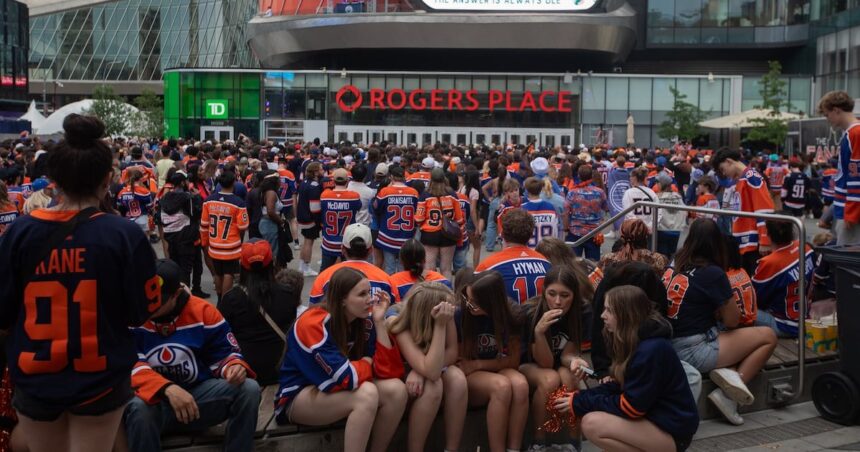As I strolled down Whyte Avenue last week, the energy lingering from our Oilers’ playoff run was still palpable. Even though our boys in orange and blue didn’t bring home the Cup, they certainly delivered something substantial to our city’s restaurants and bars.
According to a fascinating new report from Moneris, Edmonton’s food and drink establishments experienced a remarkable 12% boost in sales during those thrilling playoff months. That’s not just a number on a page – it represents real recovery for local business owners who’ve weathered some challenging years.
“We haven’t seen this kind of consistent traffic since before the pandemic,” shared Marcus Degroot, owner of The Pint on Whyte Avenue, when I stopped by to discuss the report. “Game nights were absolute madness – the good kind. We had lineups starting three hours before puck drop.”
The report highlighted what many of us witnessed firsthand: restaurant sales jumped a staggering 21% on home game days compared to regular days. What struck me most was the ripple effect beyond the immediate Ice District area.
Neighborhoods like Ritchie, Garneau, and even suburban spots in Mill Woods saw significant increases. This wasn’t just about the downtown core – Oilers fever spread throughout our entire city.
Emily Nguyen, who operates Saigon Fresh in south Edmonton, told me something that perfectly captures this phenomenon: “We’re nowhere near Rogers Place, but on game nights, every table was filled with people in Oilers jerseys. We started offering blue and orange cocktails. They sold out every time.”
The numbers confirm what business owners are saying. The Moneris data shows transaction volumes increased by 17% overall during the playoff period compared to the same timeframe last year. Even more telling, the average transaction amount rose by 9% – suggesting people weren’t just eating out more often; they were spending more when they did.
I remember walking past packed patios during that unseasonably warm evening when we clinched the Western Conference Finals. Conversations with servers that night revealed many were making double their usual tips. This playoff run wasn’t just entertainment – it represented meaningful income for our service industry workers.
City economists estimate the total economic impact at approximately $75 million. While impressive, what matters more is how that money flowed through our community. Local supplier Northern Quality Meats reported a 30% increase in orders from restaurants during the playoff period.
“We had to bring on three temporary staff just to keep up with demand,” explained owner James Harrington. “That’s money going directly into Edmonton families’ pockets.”
What’s particularly encouraging about these findings is the lasting impact. Data from the Edmonton Economic Development Corporation suggests that 22% of businesses in the hospitality sector reported forming new ongoing customer relationships during the playoff period.
For perspective on what this means beyond the numbers, I spoke with economist Patricia Mohr from MacEwan University. “Sport-driven economic boosts are often dismissed as temporary,” she explained during our coffee meeting at District Café. “But what we’re seeing here is different – it provided a psychological turning point for many establishments that were still recovering from pandemic impacts.”
This psychological boost manifests in tangible ways. Walking around Ice District now, you’ll notice fewer vacant storefronts than six months ago. New restaurant concepts are emerging, with owners specifically citing the renewed energy downtown as their motivation.
The report wasn’t all celebration, though. It noted restaurants farther from major gathering areas saw minimal impact, and some establishments reported challenges with staffing during peak periods. This uneven distribution of benefits reflects broader patterns in our economy.
As I reflect on what this means for Edmonton, I’m reminded of a conversation I had with a server at Merriot Downtown during game six. “It’s not just about the money,” she told me while juggling multiple orders. “It’s about the city feeling alive again. We needed this.”
Whether you’re a die-hard hockey fan or someone who barely knows what offside means, these findings highlight something important about our city. When Edmonton comes together around a shared experience, the benefits extend far beyond the emotional – they create tangible economic resilience.
The question now becomes: how do we maintain this momentum? The playoffs are over, but the appetite for community connection remains. Perhaps that’s the real takeaway from this report – beyond the dollars and cents, it’s a reminder of what makes Edmonton special.
Our restaurants aren’t just places to eat; they’re where our community comes together. And apparently, they’re also where we collectively spend quite a bit more money when Connor McDavid is working his magic.







